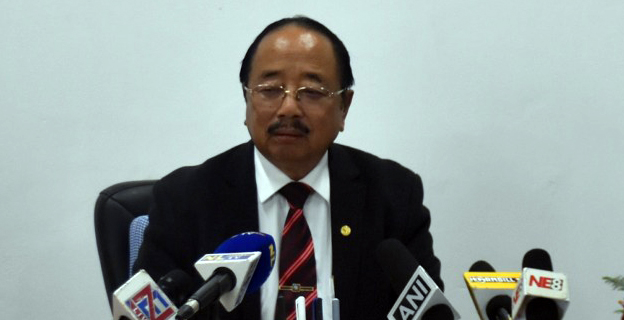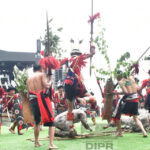With Nagaland sharing not only a 213.12 kilometer-long border with Myanmar, but also inhabited by a people with a common shared history, it is no surprise that Naga tribes living along the Indian side of the international border long to reunite with their cousins who live in Myanmar’s remote far north-west.
There has also been much discussion about the various efforts made by the Centre over the years to strengthen the Indo-Myanmar ties, making it easier for the neighbours to share a close relationship.
Larüri village, which is part of the Phokhungri subdivision in the Phek district in Nagaland and is inhabited by the Pochury tribe, is one of many that have a close relationship with their cousins across the border.
In an interview with Mokokchung Times, K. Lanshitsü Thüvüri, president of the Larüri Development Council, stated that many Nagas from Myanmar end up in Nagaland to pursue theological studies as well as secular education.
Pintshotsu, the DB-II Avakhung village, also agreed. Avakhung village is approximately two hours from Leyshi, Myanmar, where many Nagas of various tribes live alongside many other tribes. Leshi, also known as Layshi, is a township in the Naga Self-Administered Zone of Myanmar’s Sagaing Region.
They believe that after receiving an education in Nagaland, people from Leyshi would return to their native land and establish businesses.
“One day, I ran into someone from Leshi. He stated that he attended a college in Kohima and now runs a school there,” Thüvüri recollected about the number of Nagas he had met from across the border.
“People from Leyshi would travel to Avakhung village in groups of five or so on foot or by vehicle to sell items such as chilly, the most common vegetable sold in the village. They also bring in really strong mountain bikes and chainsaws that the villagers buy,” he said, adding that people from Myanmar would buy sugar, milk, noodles, and other items in return on their way home.
“They actually have a lot of modern facilities, such as bikes that are popular among the villagers. However, they also end up purchasing Bolero, pick-up trucks, Scorpio, and a variety of other Indian motorcycles. We see a lot of Indian vehicles in Leyshi town,” Pintshotsu, who is from Avakhung village, added.
How free is it to move across the border?
In terms of free movement, the gentlemen stated that trade borders are not heavily restricted.
According to Pintshotsu, the Army would frequently check their identity cards or Aadhar cards and record them in a register while ensuring that illegal trade such as drugs and guns were not practiced.
“General public trading is permitted. We just need to make a request, and once they permit us, we can carry loads of products without any restrictions,” Pintshotsu explained, adding that things have, however, changed since the military coup in Myanmar.
“After the military coup in Myanmar, we stopped going there as much. Even they don’t come very often but there are people who go at their own risk,” he added.
It may be mentioned that the Indo-Myanmar border is an open border with free movement regime (FMR) within 16 kms on both sides of the border.
How do people interact?
Trading has been made possible despite the language barrier, as explained by the two gentlemen. Thüvüri stated that they either communicate with many gestures or that the Leyshi people frequently communicate with them in a ‘broken Nagamese dialect’. He believes that the pidgin language influenced them during their stay in Nagaland.
“Within themselves, they usually communicate in Somra. I believe it is a common language in a few villages over there,” he guessed.
Medium of exchange
Regarding the medium of exchange between Myanmar Kyat and Indian Rupees, Thüvüri stated that there are specific shops that exchange the currency, as well as individuals who are involved in doing such currency exchange business.
“One Rupee is approximately 17 Kyat. Their currency fluctuates with the market economy, so it sometimes reaches 18, 20 or so,” he added.
Meanwhile, Pintshotsu also said that their currency, depending upon the market value, would come down as low as 24 Kyat for one Rupee while other times it would be at 20 Kyat for a Rupee.
Cultural exchange
The two gentlemen from two different villages revealed that Nagas cutting across the border share a strong cultural bond in addition to an economic one.
They both admitted that they had received invitations from the Leyshi side for their New Year’s celebration. According to Pintshotsu, their New Year celebration is similar to Nagaland’s Hornbill Festival, where various tribes perform cultural dances and songs.
“In terms of folk songs and dances, we have a lot of cultural commonalities,” Pintshotsu said.
Thüvüri also stated that they occasionally share each other’s folk songs and that they have a strong cultural relationship.
Relationship beyond economy
Culture is said to be one thing that unites people. With similar cultures being shared within such close proximity, there is no doubt that human relationship and emotions are prone to grow.
Thüvüri in his own words said that the love and care they have for each other stands strong to this day. Recalling an incident that unfolded in 2015, he said, “I was on a trip with some friends near their area when our car broke down in the middle of the road. We saw two gentlemen returning from a village there. One of my friends called out, “Sati, Sati, I have a request for you,” and they said, “Sure, sure, what is it?”
My friend then said, “We have a lot of stuff to carry; could you please assist us? Sure, why not! said the two of them. We’re all Nagas, so why won’t we assist you? We’ll do what we can,” and then the two of them assisted us in carrying our luggage. That was truly a great experience and yes, they are physically very strong. We ended up sleeping at the VC’s house where they served us a hearty meal,” he narrated.
Meanwhile, Pintshotsu stated that because it is easier and closer for them to go search for a hospital in Leyshi rather than Kohima or Dimapur, the villagers would frequently go to the hospitals in Leyshi. “They have a really good hospital there,” he added.
According to Pintshotsu, the Government of India in 2019 has approved of a Trade Centre in their village, Avakhung, where they aim to connect with countries like “Burma, Thailand and some other countries.”
“We were told that goods like marble stone, cement and other tradeable products will be stocked in our village which will be transported to a trade center in Pungro from where products will be supplied to various places. Both our Nagaland government & Indian government are involved in it but the implementation has not been started,” he said.
It may be recalled that back in 2007 during the Look East Policy of the Manmohan Singh government, the Centre has approved setting up five Border Trade Centres (BTC) along Indo-Myanmar border in Nagaland to promote trade and commerce in the state which included Lungwa in Mon district, Pangsha in Tuensang district (now Noklak), Mimi in Kiphire district, Mohe, Avakhung in Phek district.
It was also reported that the Nagaland Chief Minister Neiphiu Rio along with his colleagues and 2 MPs from Myanmar with 14 delegates in 2013 took a 30-minute walk through the jungles of Avakhung and physically inspected the ongoing road construction along Indo-Myanmar border between Avakhung village in Phek district and Leyshi in Myanmar in an attempt to get a full-fledged International Trade Centre.
Thus, it can only be expected that the relationship will be further strengthened as Narendra Modi’s government gears up towards its ‘Act East Policy’.
(Mokokchung Times expresses our heartfelt gratitude to Tümüzo Katiry for collaborating with us in writing this report)



